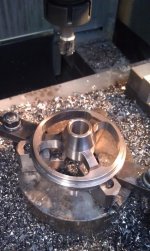Ukraine Train
Cast Iron
- Joined
- Feb 10, 2014
- Location
- Ohio
I'm milling these pockets in annealed 8620 with an Iscar Heli2000 with APKT inserts. 500SFM, .005IPT, ramping down at 2° to .150" deep per pass. I get a loud screech as it goes around and it's leaving chatter marks. Interestingly, I started this job with worn inserts and it went ok, but when I flipped to the fresh side I started having the issue. I tried adjusting speed and feed with no effect. Any suggestions?
Also, what's a good way to deburr the corners of this on both ends? Hand held flap wheel? Wire wheel? Thanks for any tips.

Also, what's a good way to deburr the corners of this on both ends? Hand held flap wheel? Wire wheel? Thanks for any tips.



